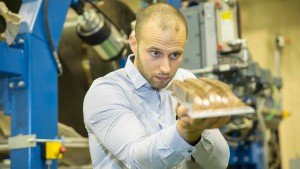 Composite materials comprised of plastics and fibers are firmly established in the field of structural lightweight design. While the most commonly used are glass and carbon fibers in a thermoplastic matrix, researchers at the Federal Cluster of Excellence MERGE have taken a different approach. Ahmed-Amine Ouali, research associate at the Institute of Lightweight Structures explained: “We replace the glass or carbon fiber with natural fibers such as flax. Our plastic matrix is a biopolymer of renewable resources. Thus, the carbon footprint in the product’s life cycle is significantly better.”
Composite materials comprised of plastics and fibers are firmly established in the field of structural lightweight design. While the most commonly used are glass and carbon fibers in a thermoplastic matrix, researchers at the Federal Cluster of Excellence MERGE have taken a different approach. Ahmed-Amine Ouali, research associate at the Institute of Lightweight Structures explained: “We replace the glass or carbon fiber with natural fibers such as flax. Our plastic matrix is a biopolymer of renewable resources. Thus, the carbon footprint in the product’s life cycle is significantly better.”
The material characteristics are also interesting: The use of continuous filaments renders the compound extremely stiff and highly rigid in the direction of the fibers. As an additional plus point, flax is lighter than glass and cheaper than carbon fiber.
The researcher’s main objective was to develop a procedure for the large-scale production of so-called semi-finished products made from plastics and natural fibers. Film-stacking-technology – a discontinuous procedure – is currently common practice. In this procedure, single layers (for example plastic film, non-crimp fabric, plastic film) are stacked into a heat press, fused under pressure, removed and further processed into sheets in another machine. For the continuous procedure, a new rolling mill, a so-called calender, had to be developed.
“Natural fibers have a special characteristic in contrast to glass or carbon fibers: they readily absorb fluids. Thus, prior to the processing, they have to dry”, explained Ouali. “At the institute, we developed a dryer plant that could be attached to the calender almost without space in between. This way the dried fiber has almost no contact to the moist ambient air.” The Omega calender, named after its shape, is the heart of the continuous production path. It consists of several cylinders through which the flax fiber plastic films can theoretically be continuously fed, heated up, and pressed together.
After the impregnation process and the cooling of the so-called thermoplastic prepregs, the fiber matrix semi-finished product, is complete. It is wound up on a role and can be further processed in various ways. Cut to size and with numerous layers pressed as a stack a rigid sheet emerges. “We can also form the semi-finished product once more and combine it with injection molded products. Both in just one process. This way we produced our technology demonstrator, the lightweight carrier component”, said Ouali.
The production procedure is currently intermittent, with a stop after the continuous production of the prepreg semi-finished product. Depending on the researcher’s need, production then continues in numerous different plants. For large-scale production, the manufacturing path can be supplemented or combined accordingly.
“We developed promising, sustainable, durable materials, whose production is significantly more energy-efficient and thus shows a better carbon footprint than in conventional fiber-plastic compounds”, said Ouali. Looking to the future he explained: “We will further experiment with various fiber structures as knitted or non-crimp fabrics, or in other forms and with different matrix combinations for example films or spun-bonded fabric.”
Source
Bioplastics MAGAZINE, 2017-07-17.
Supplier
Professur Strukturleichtbau und Kunststoffverarbeitung der TU Chemnitz
Technische Universität Chemnitz
Share
Renewable Carbon News – Daily Newsletter
Subscribe to our daily email newsletter – the world's leading newsletter on renewable materials and chemicals










